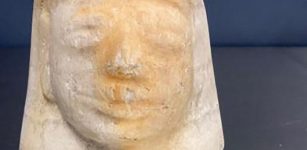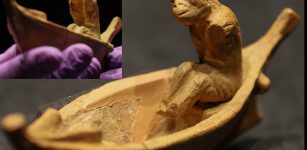Viking King – How Was He Elected And What Was Expected From Him?
Ellen Lloyd - AncientPages.com - In Viking society, kings were the most influential people, but having the highest social status was associated with responsibilities and particular requirements. Unlike pharaohs, Viking kings were not considered divine or unique.
Travis Fimmel as Ragnar Lothbrok in the TV series Vikings. Credit: History Channel - Copyright, fair use.
Ragnar Lodbrok claimed to be a direct descendant of the god Odin, but most Viking leaders were "ordinary" people, and they were viewed as exceptionally commanding men.
A man must have certain qualities and attitudes to become a great Viking leader.
It brings us to questions such as – Who could become a Viking king? Who was considered a worthy leader in the Viking society?
Kings Appeared At The End Of The Viking Age
It's important to remember that there were no Viking kings during the early Viking Age. The Viking society was divided into three social classes - the nobles or jarls, the middle class or karls, and the slaves or thralls.
Although the different social layers within the population were perceived as ordained by the Norse gods, it was still possible for one person to move from one class to another.
Vikings' kings appeared at the beginning of the Viking Age and were only regional leaders. The most potent individual Viking kings who ruled most Scandinavian lands appeared at the end of the Viking Age.
How Was A Viking King Elected And What Was Expected From Him?
The title of a king could be inherited. A man could also become a king if he had a good reputation and prominent supporters or was a successful military force leader.
Some were considered better-qualified leaders than others. High intelligence and capacity for strategic thinking were a requirement. A Viking king was expected to be ruthless toward his enemies, and there was no room for softness.
A Viking king must attend many important meetings with other chiefs; physical appearance was significant to gain respect. It could be achieved if a king had a strong body and wore beautiful clothes.
A Viking King Must Be Generous And Rich
Generosity was also a central trait of a worthy leader. A Viking mustn't be greedy. He was obliged to distribute wealth in gifts and by other means.
Gifts were given in weapons, gold rings, clothes, and sometimes ownership of land.
Our previous article on Ancient Pages discussed the importance of a Viking king's hird.
Members of a hird were Viking warriors and professional bodyguards prepared to die for their leader. An influential Viking chief had many enemies lurking everywhere. He had to be protected to stay in power, but Norse warriors did not fight for free.
A Viking leader who had a hird must be able to pay his warriors through gifts such as gold and silver, clothes, and weapons. Warriors also needed proper accommodation, food, and drink to protect their leader all around the clock. So, a Viking king had to be rich.
It's also worth mentioning that even a Viking king could be sacrificed.
The poem Ynglingatal tells how a Viking king was sacrificed in Sweden to restore his relationship with the gods.
Written by Ellen Lloyd – AncientPages.com
Updated on April 11, 2023
Copyright © AncientPages.com All rights reserved. This material may not be published, broadcast, rewritten or redistributed in whole or part without the express written permission of AncientPages.com and Ellen Lloyd
More From Ancient Pages
-
 Scientific Disagreement Over The Bronze Age Tin Ingots From The Uluburun Shipwreck
Archaeology | Sep 25, 2023
Scientific Disagreement Over The Bronze Age Tin Ingots From The Uluburun Shipwreck
Archaeology | Sep 25, 2023 -
 Unexplained Disappearance Of East Balkan Civilizations – Discovery Of Unusual Mini Artifacts – Part 1
Civilizations | Apr 28, 2018
Unexplained Disappearance Of East Balkan Civilizations – Discovery Of Unusual Mini Artifacts – Part 1
Civilizations | Apr 28, 2018 -
 Spectacular 2,500 Years Old Shwedagon Pagoda In Myanmar – World’s Oldest Pagoda
Featured Stories | Oct 18, 2018
Spectacular 2,500 Years Old Shwedagon Pagoda In Myanmar – World’s Oldest Pagoda
Featured Stories | Oct 18, 2018 -
 Hidden 2,000-Year-Old Roman Road Uncovered In Worcestershire Could Be Of ‘Global Importance’
Archaeology | Nov 12, 2022
Hidden 2,000-Year-Old Roman Road Uncovered In Worcestershire Could Be Of ‘Global Importance’
Archaeology | Nov 12, 2022 -
 Secrets Of The Spiral Symbol Left By Ancient Civilizations
Ancient Symbols | Mar 11, 2016
Secrets Of The Spiral Symbol Left By Ancient Civilizations
Ancient Symbols | Mar 11, 2016 -
 Captain James Cook’s Famed Vessel The Endeavour Possibly Discovered On The Coast Of Rhode Island
Archaeology | Feb 4, 2022
Captain James Cook’s Famed Vessel The Endeavour Possibly Discovered On The Coast Of Rhode Island
Archaeology | Feb 4, 2022 -
 On This Day In History: ‘Sea King’ Ragnar Lodbrok Seizes Paris – On March 28, 845
Featured Stories | Mar 28, 2016
On This Day In History: ‘Sea King’ Ragnar Lodbrok Seizes Paris – On March 28, 845
Featured Stories | Mar 28, 2016 -
 Ancient Giants In Ecuador Were Killed By Fire From The Sky – Indian Legends Reveal
Featured Stories | Dec 12, 2017
Ancient Giants In Ecuador Were Killed By Fire From The Sky – Indian Legends Reveal
Featured Stories | Dec 12, 2017 -
 Funerary Urn Depicting The God Of Corn Unearthed In Mexico By INAH Archaeologists
Archaeology | Jan 11, 2024
Funerary Urn Depicting The God Of Corn Unearthed In Mexico By INAH Archaeologists
Archaeology | Jan 11, 2024 -
 Florida’s Windover Bog Bodies Predate The Egyptian Pyramids And Can Rewrite Ancient American History
Featured Stories | Jun 3, 2021
Florida’s Windover Bog Bodies Predate The Egyptian Pyramids And Can Rewrite Ancient American History
Featured Stories | Jun 3, 2021 -
 History Mystery: Gold Tool Found In Jerusalem Cemetery Baffles
Archaeology | Dec 25, 2015
History Mystery: Gold Tool Found In Jerusalem Cemetery Baffles
Archaeology | Dec 25, 2015 -
 3,000-Year-Old Ancient Egyptian Artifact Seized By US Agents In Memphis
Archaeology | Aug 29, 2022
3,000-Year-Old Ancient Egyptian Artifact Seized By US Agents In Memphis
Archaeology | Aug 29, 2022 -
 Seti I – Remarkable Pharaoh Who Saved The Kingdom Of Egypt And Gave It New Glory
History | Jun 15, 2021
Seti I – Remarkable Pharaoh Who Saved The Kingdom Of Egypt And Gave It New Glory
History | Jun 15, 2021 -
 The 2,400-Year-Old Figurine Of Charon -The Ferryman Of The Dead – On Display In Izmir, Turkiye
Archaeology | Nov 21, 2022
The 2,400-Year-Old Figurine Of Charon -The Ferryman Of The Dead – On Display In Izmir, Turkiye
Archaeology | Nov 21, 2022 -
 On This Day In History: First Public And Free School Opened For Poor Children – On Sep 15, 1616
News | Sep 15, 2016
On This Day In History: First Public And Free School Opened For Poor Children – On Sep 15, 1616
News | Sep 15, 2016 -
 New Paintings And Details Uncovered In The Egyptian Temple Of Esna
Places | Oct 22, 2024
New Paintings And Details Uncovered In The Egyptian Temple Of Esna
Places | Oct 22, 2024 -
 Hidden Treasures Revealed In Unique 3D Rendering Of Robber’s Cave In Nebraska
Archaeology | Dec 11, 2019
Hidden Treasures Revealed In Unique 3D Rendering Of Robber’s Cave In Nebraska
Archaeology | Dec 11, 2019 -
 Prometheus ‘Fire Bringer’ – Hero Stealing Fire From Gods Giving It To Mortals
Featured Stories | Sep 5, 2018
Prometheus ‘Fire Bringer’ – Hero Stealing Fire From Gods Giving It To Mortals
Featured Stories | Sep 5, 2018 -
 Was The Legendary Tree Of Life Located In The Grove Of Eridu?
Featured Stories | May 19, 2016
Was The Legendary Tree Of Life Located In The Grove Of Eridu?
Featured Stories | May 19, 2016 -
 3,700-Year-Old Domed Oven Found At Troy Excavation Site Closely Related To Anatolian Culture
Archaeology | Sep 12, 2022
3,700-Year-Old Domed Oven Found At Troy Excavation Site Closely Related To Anatolian Culture
Archaeology | Sep 12, 2022

